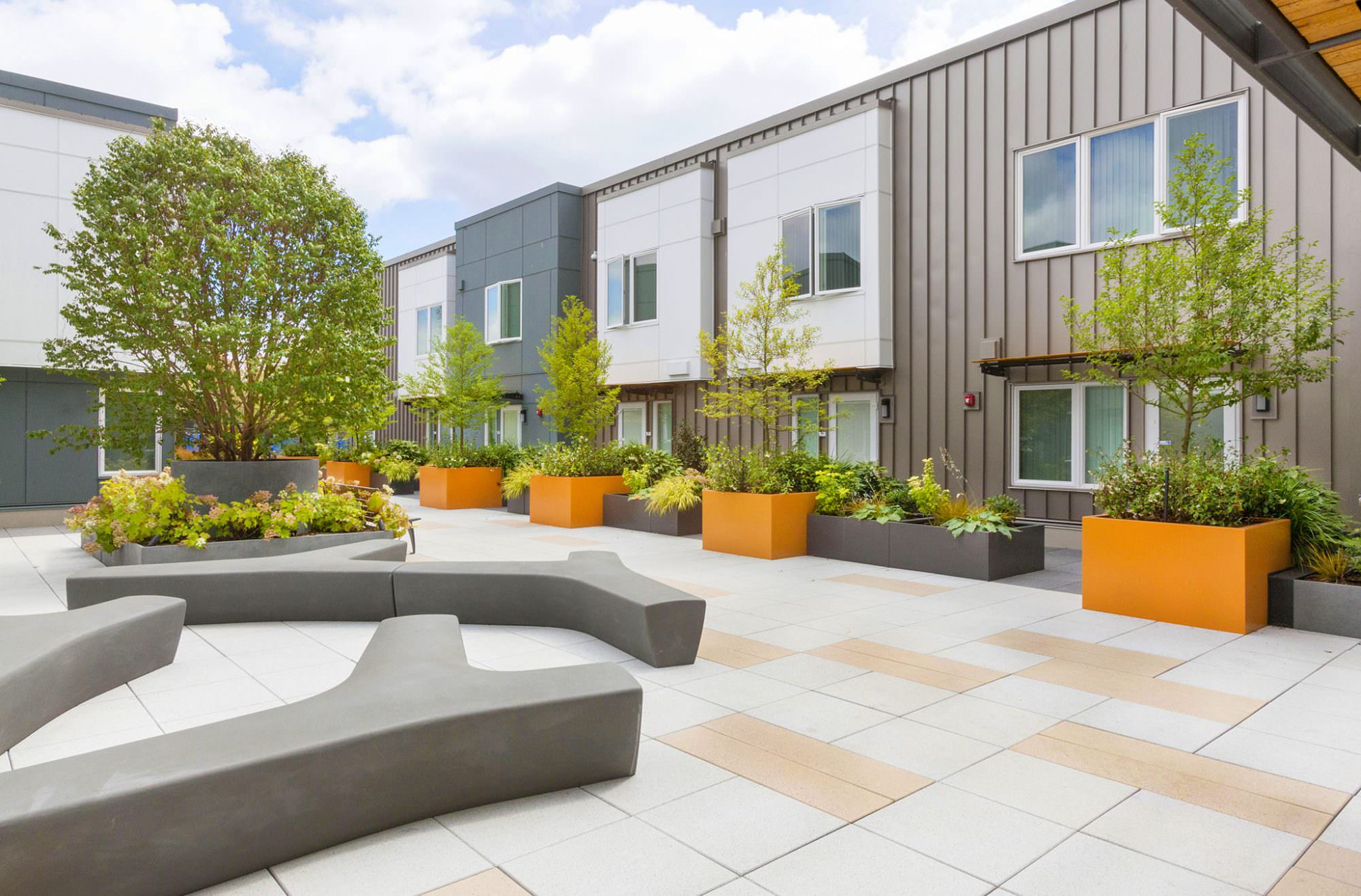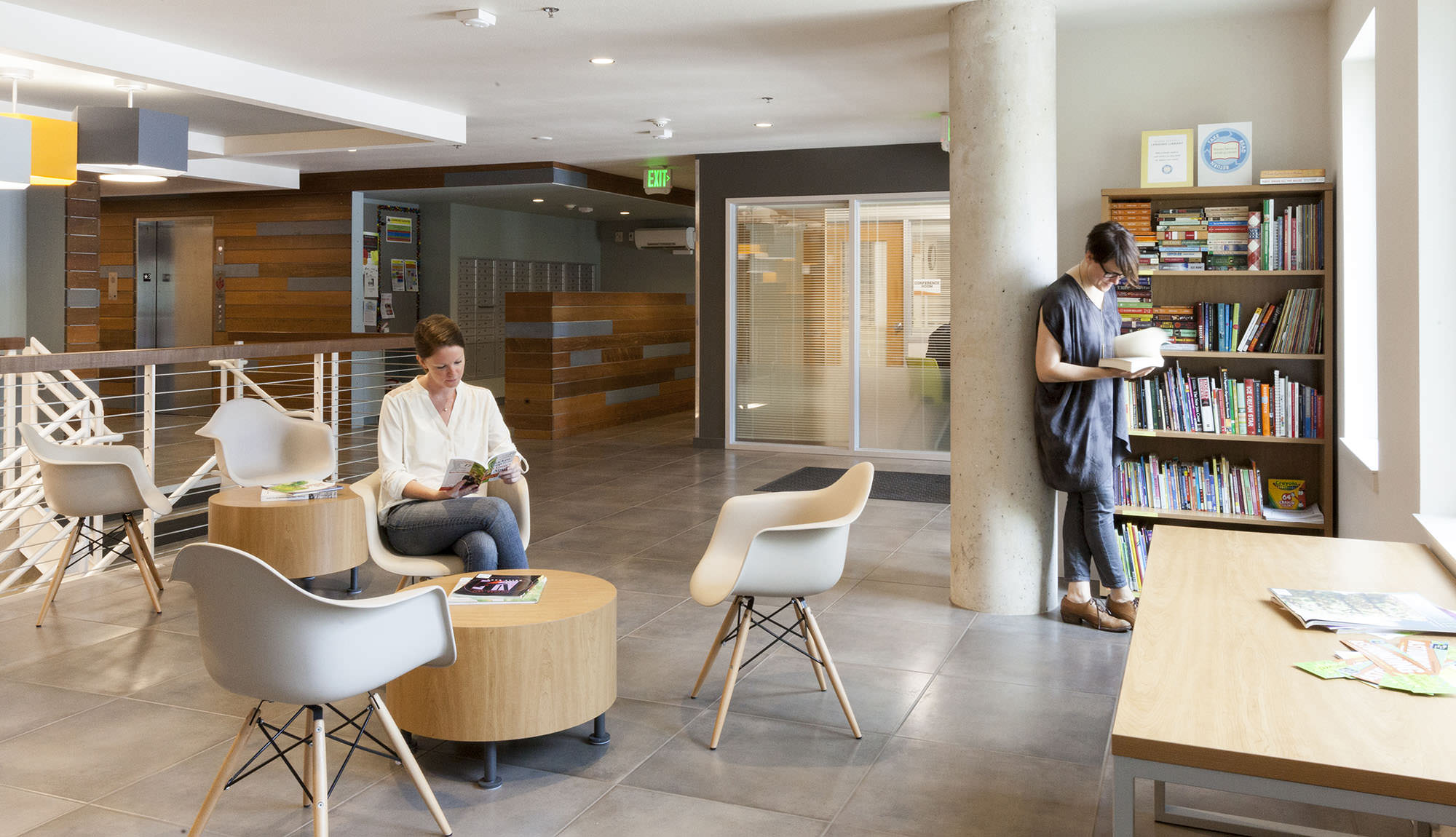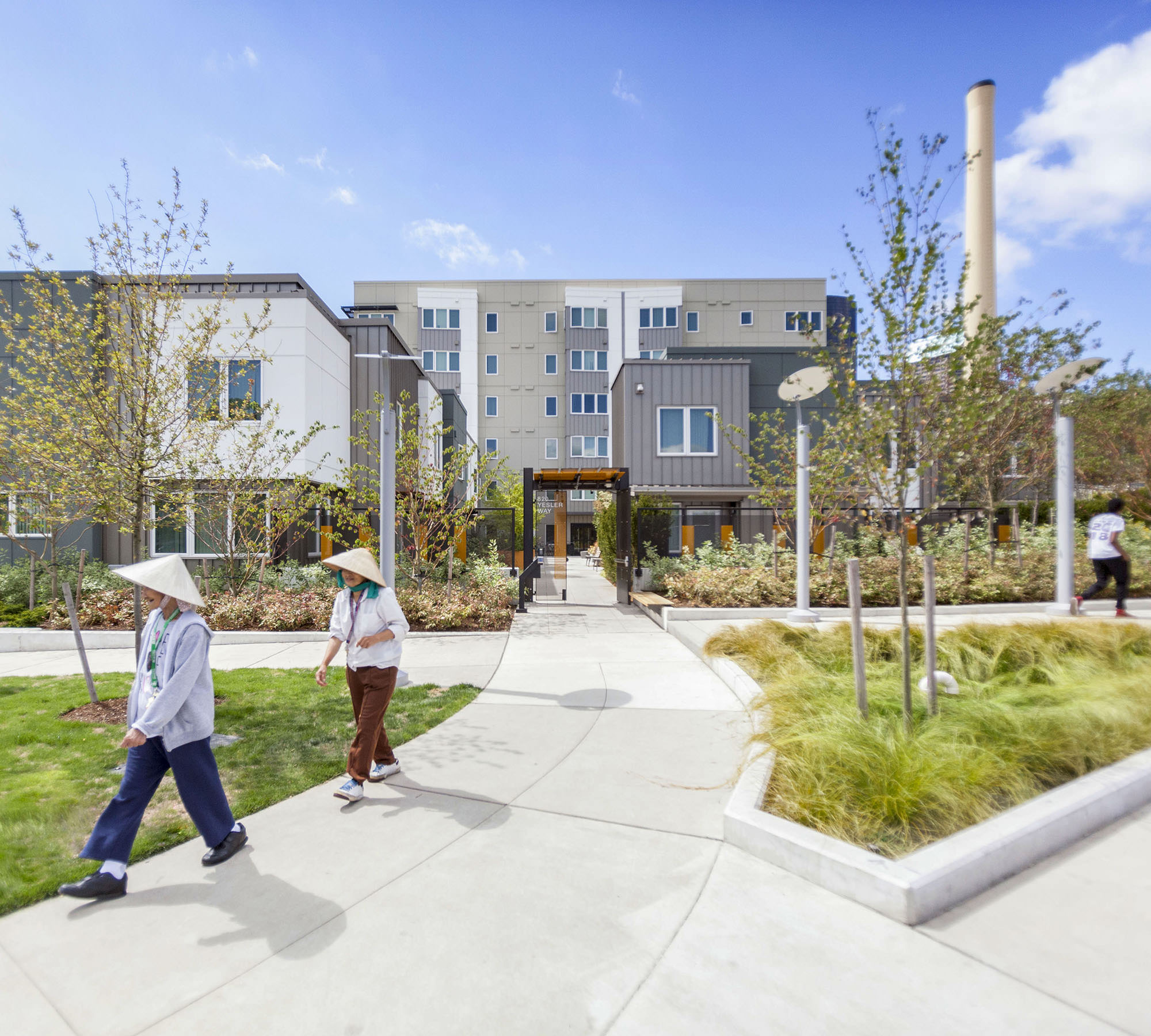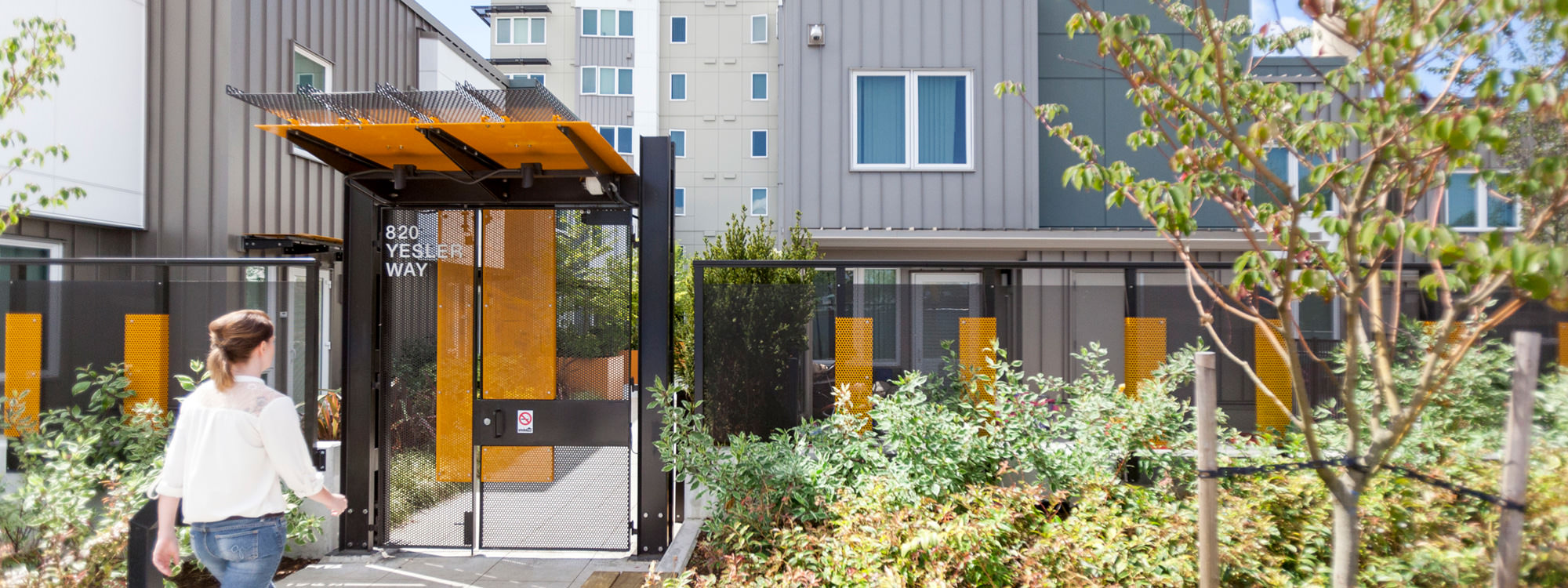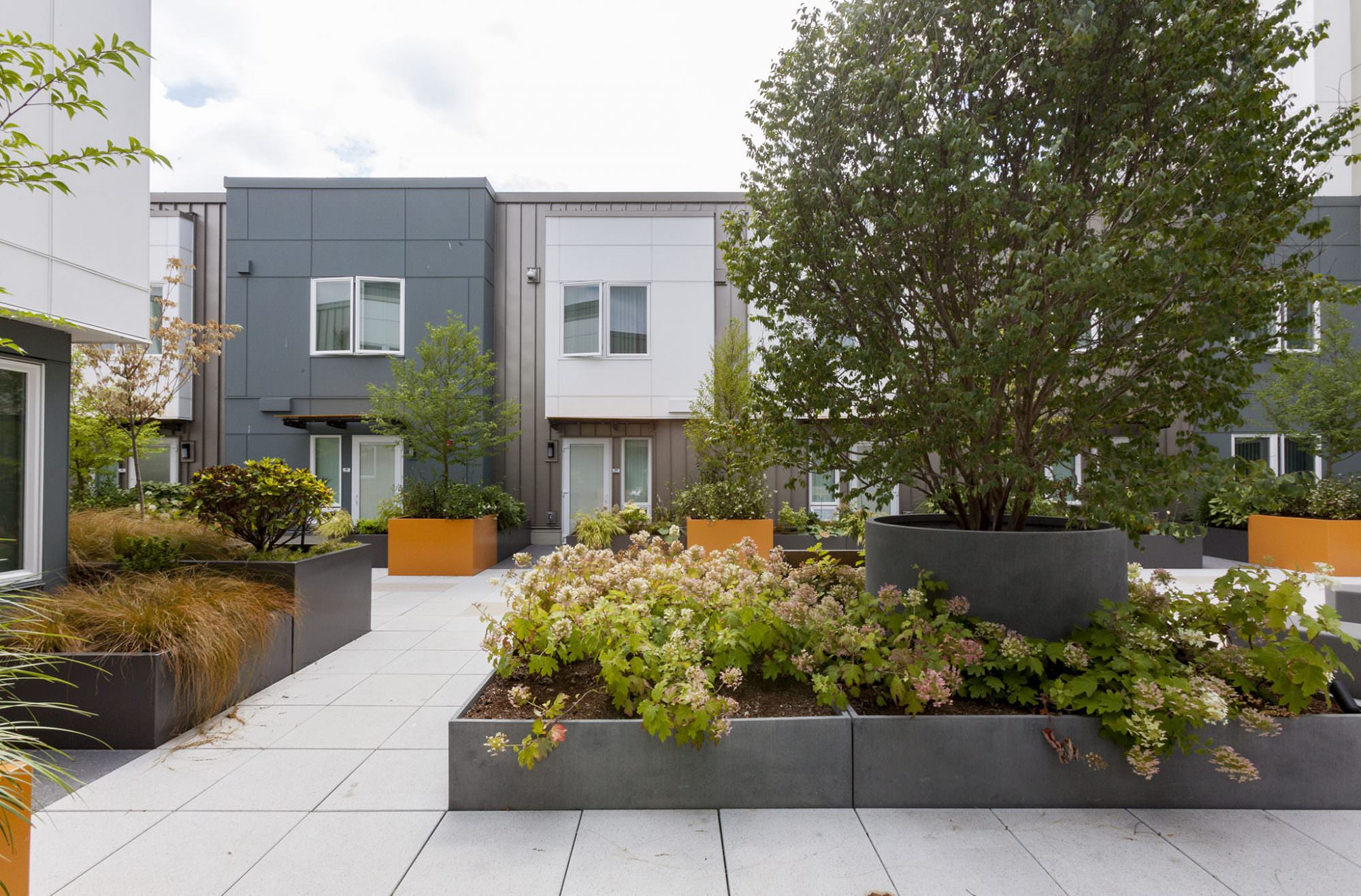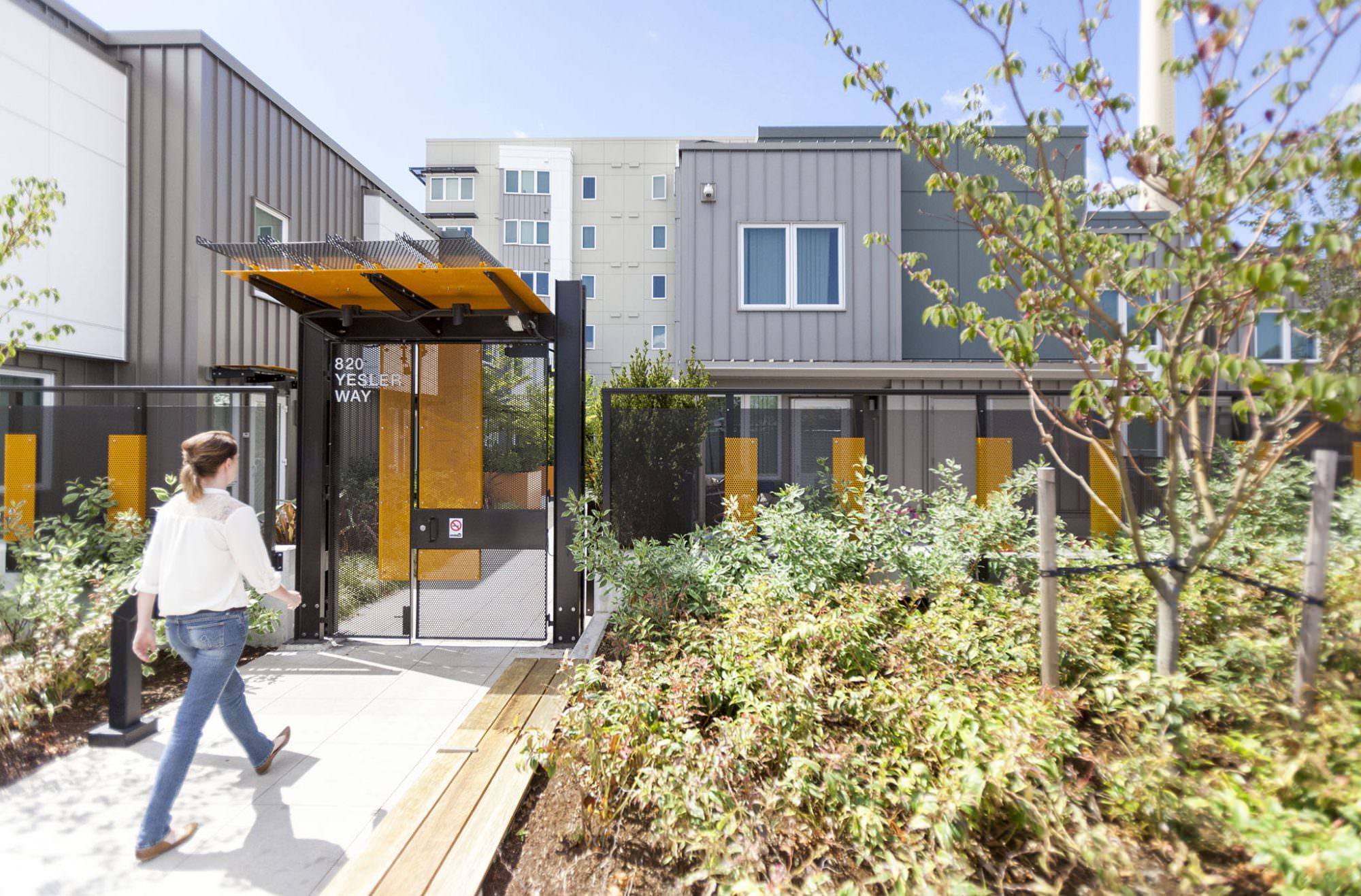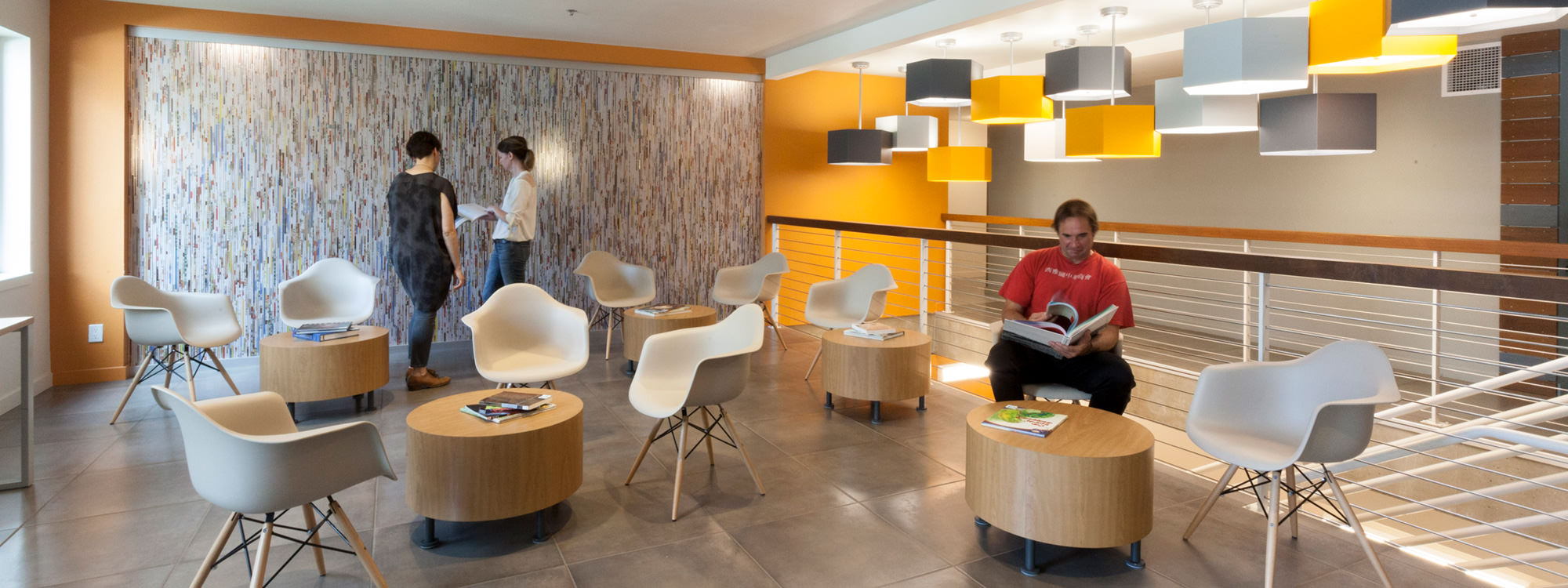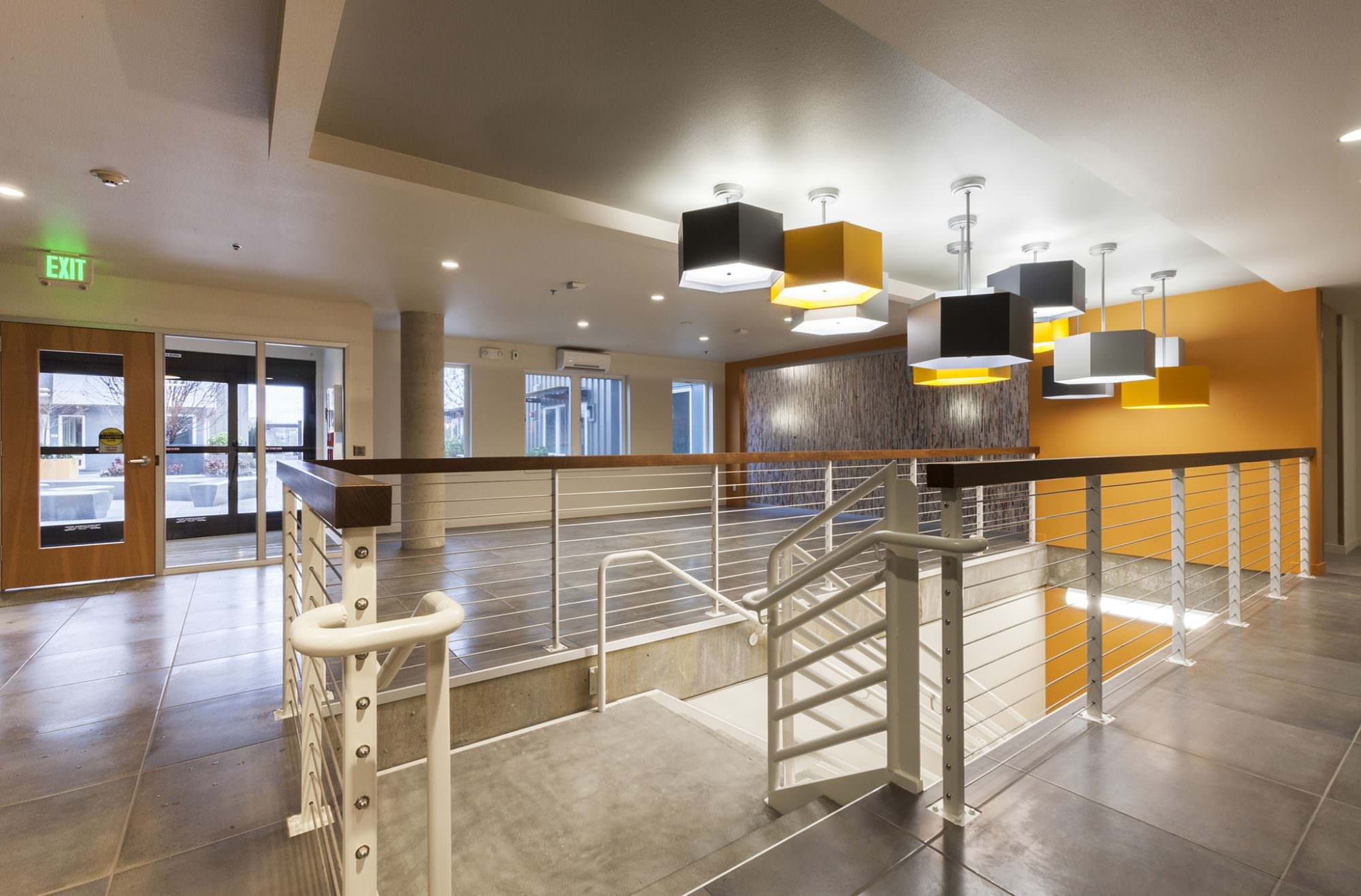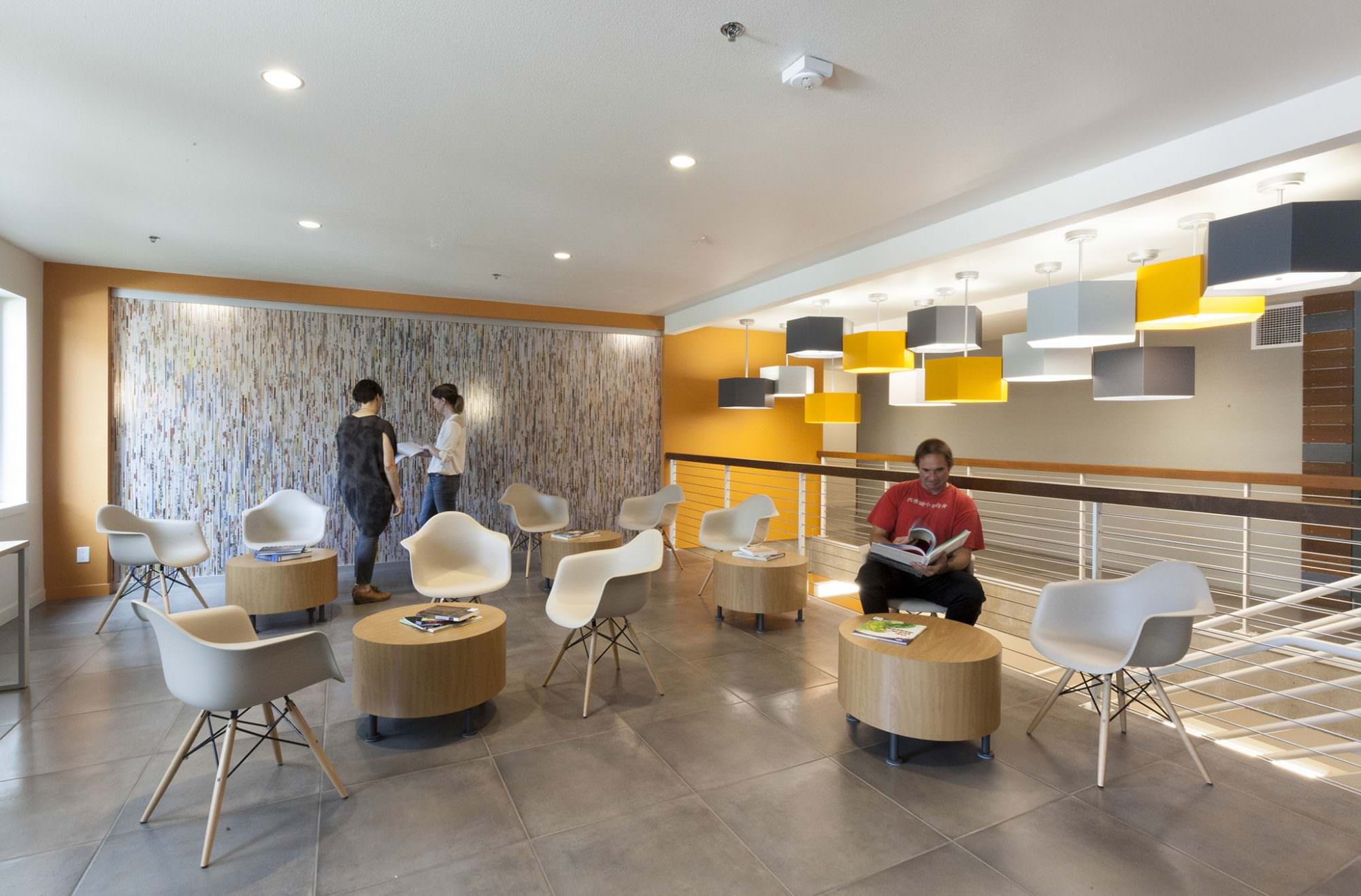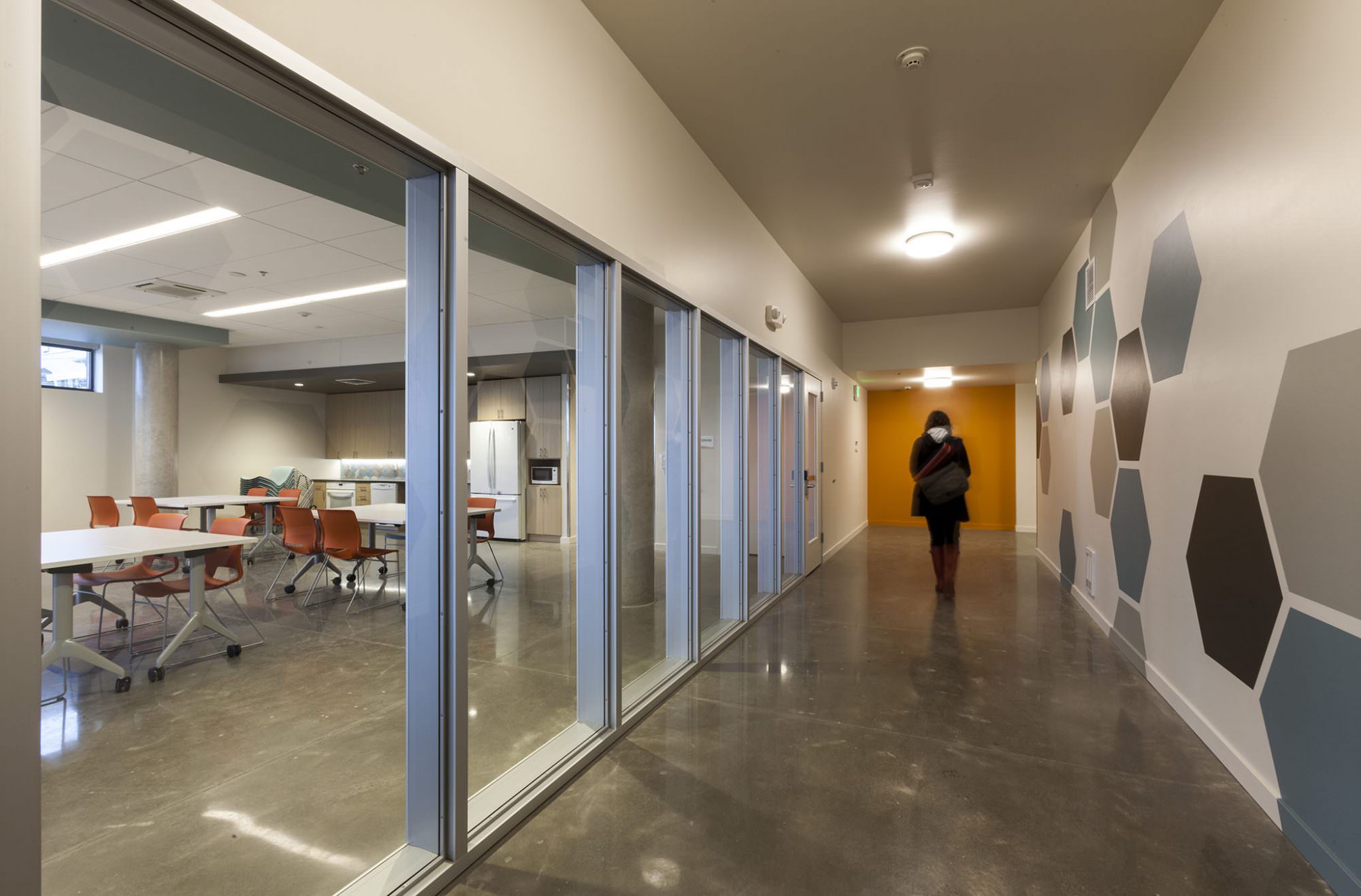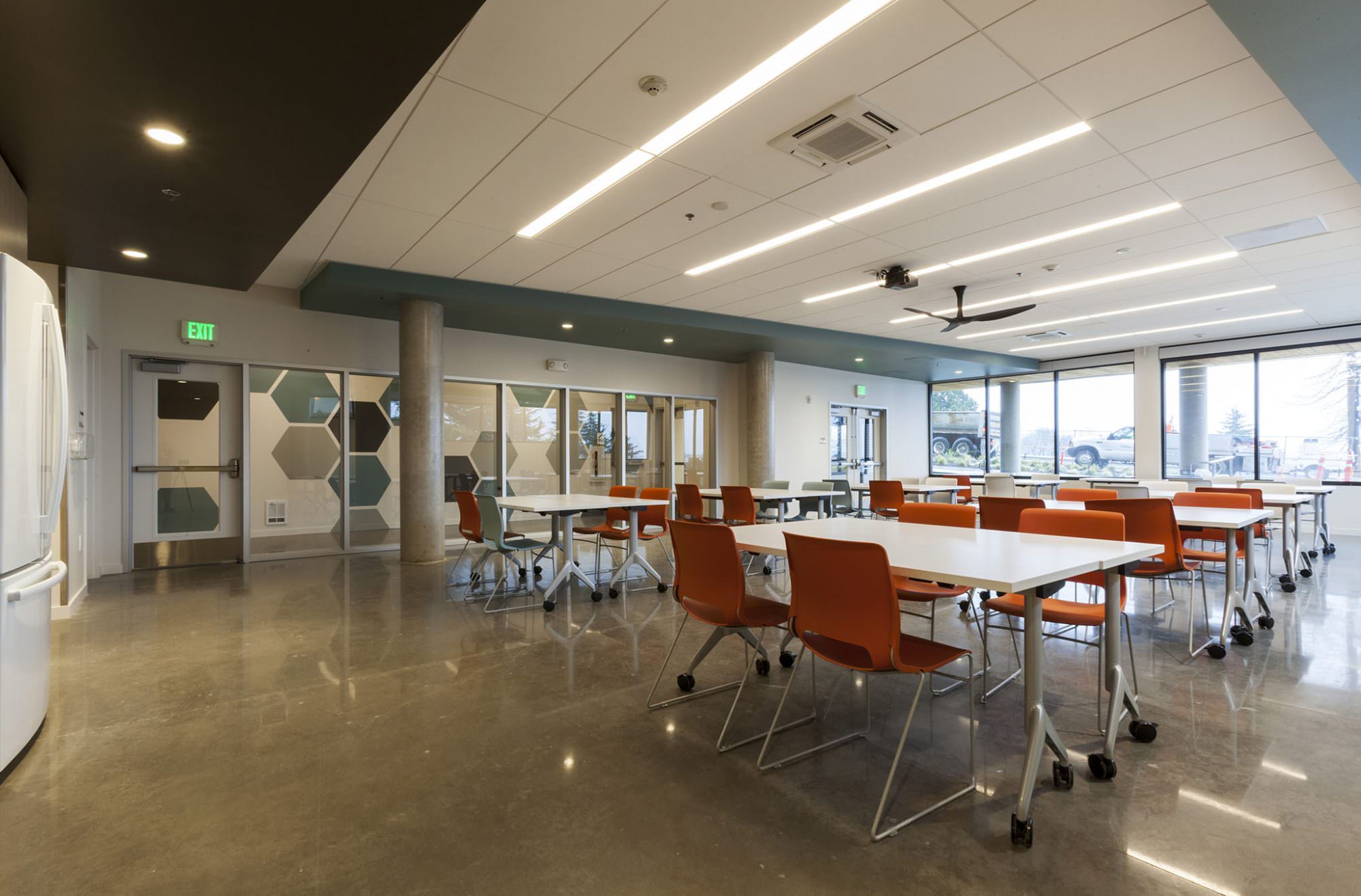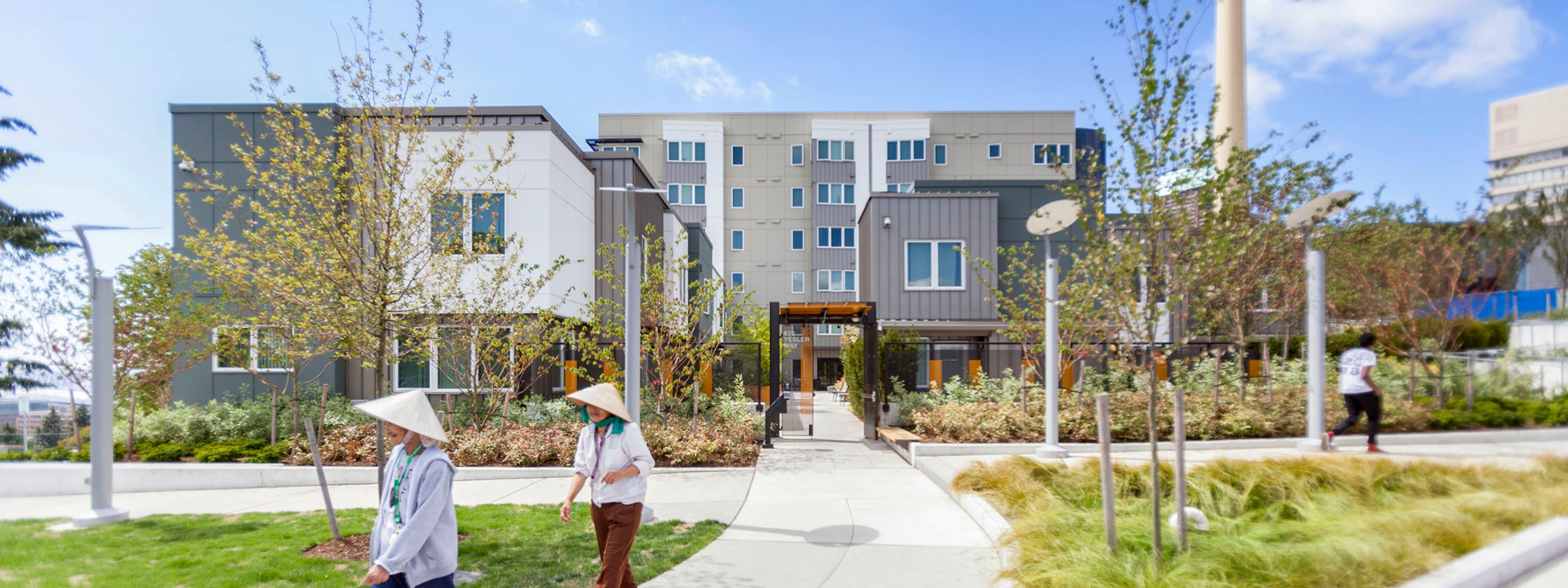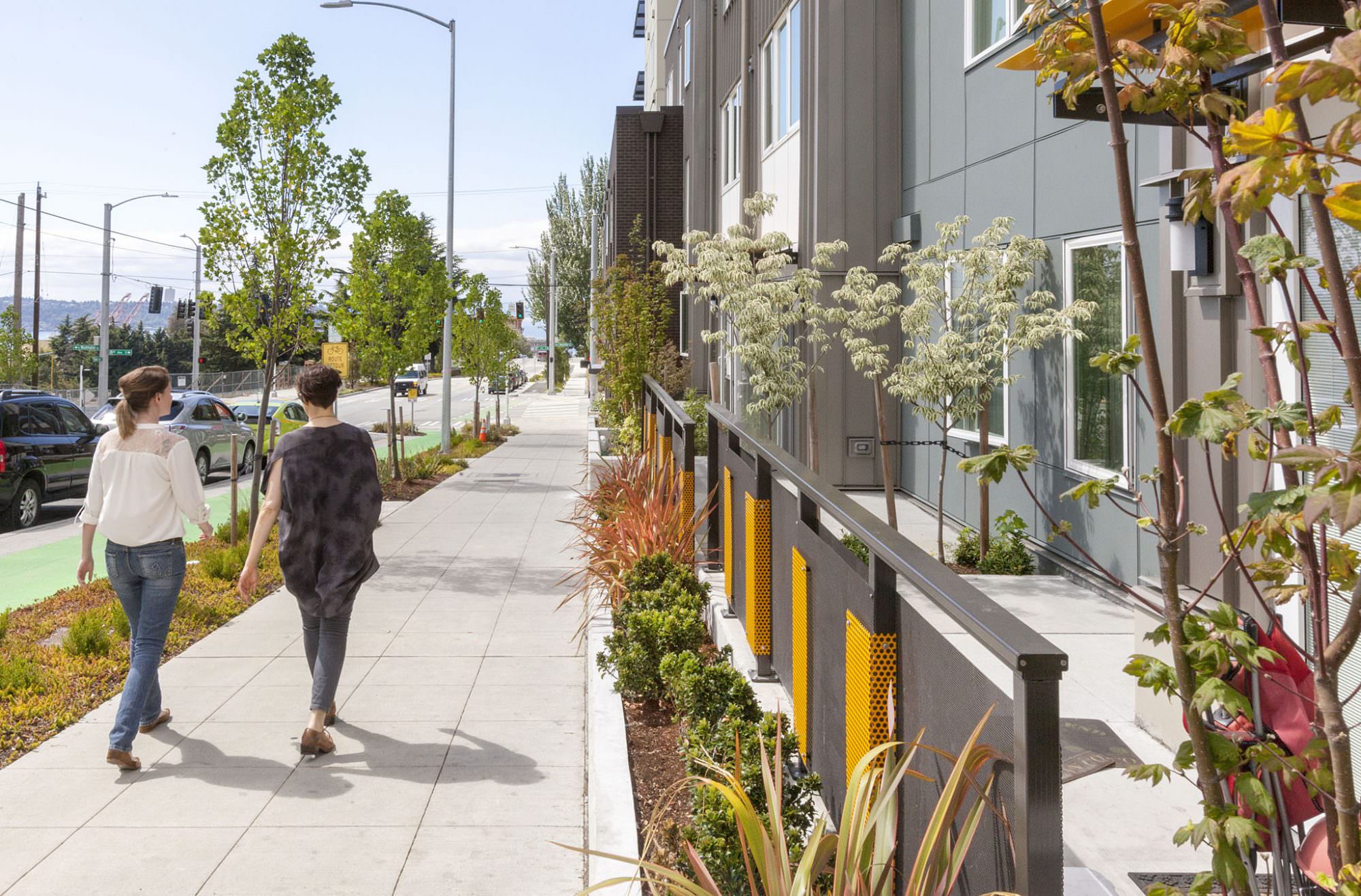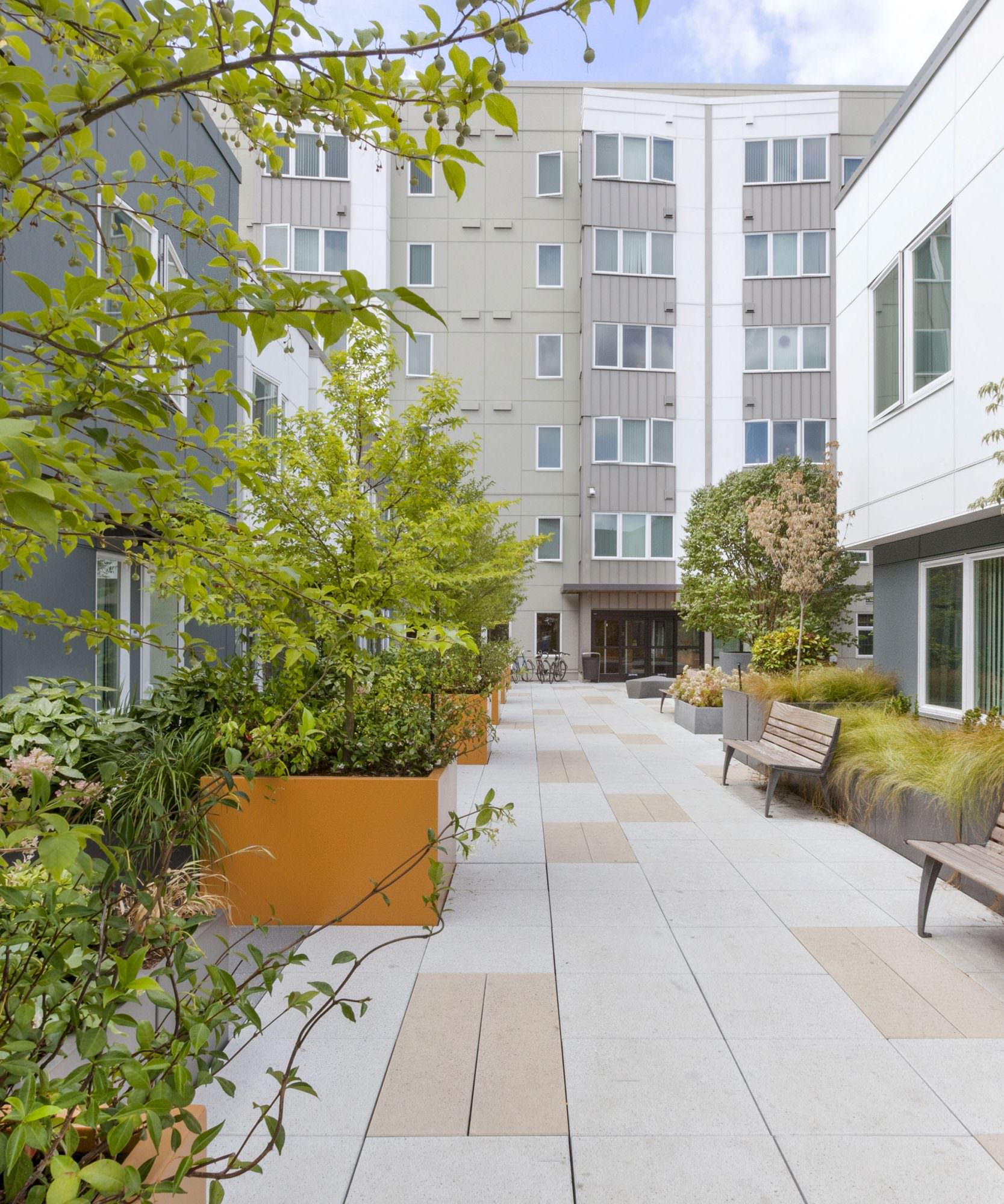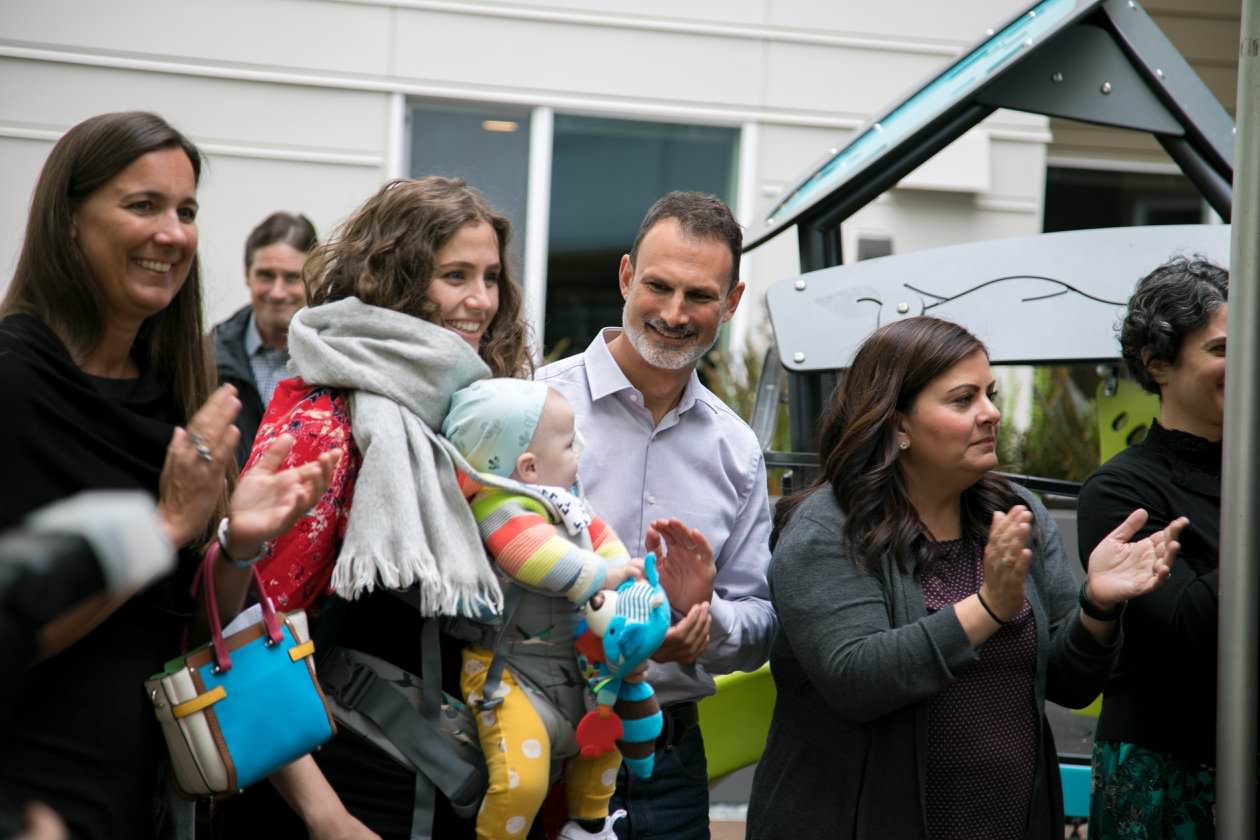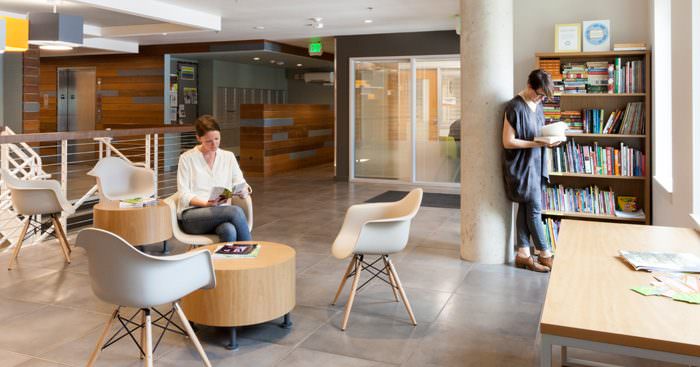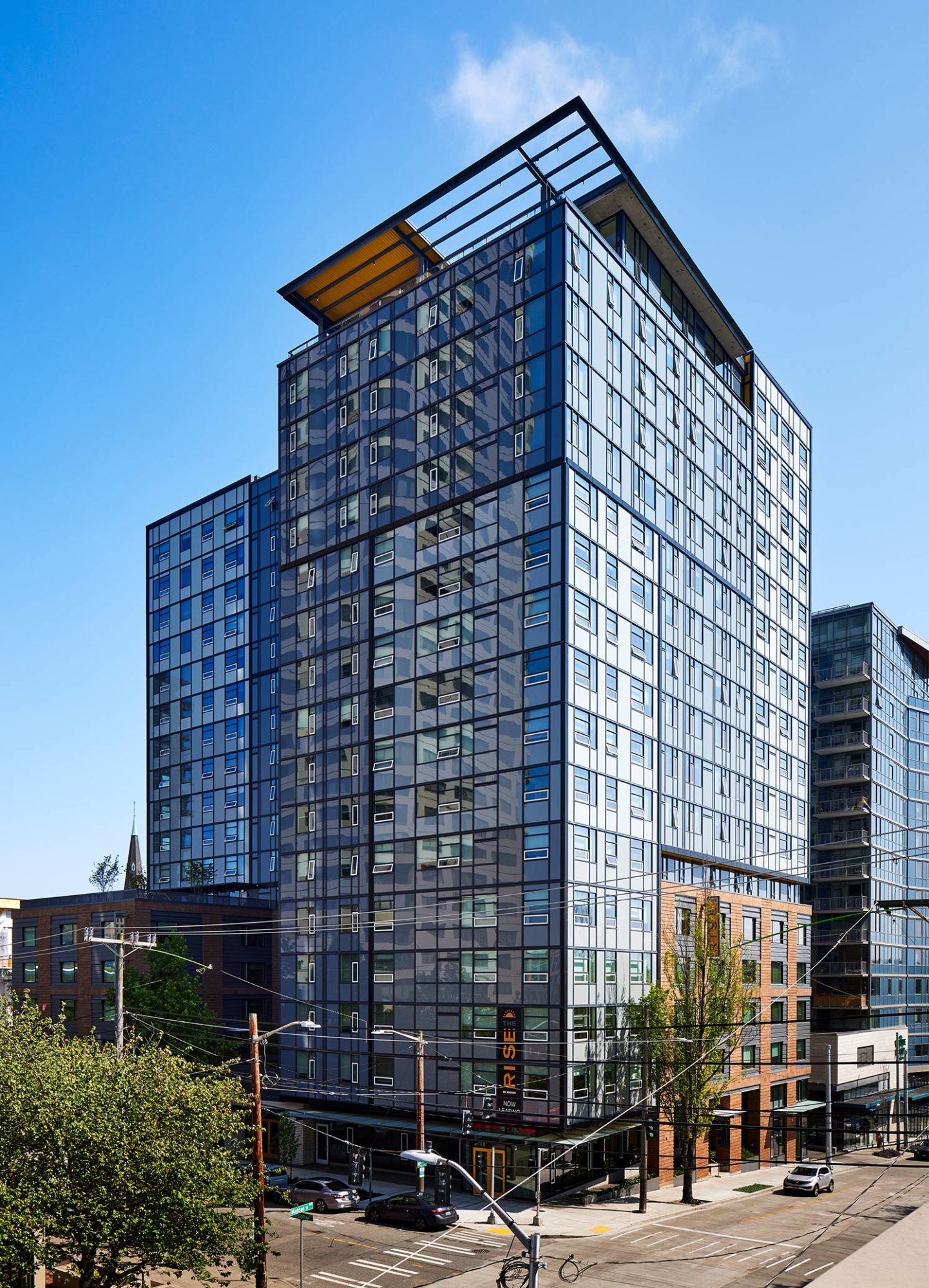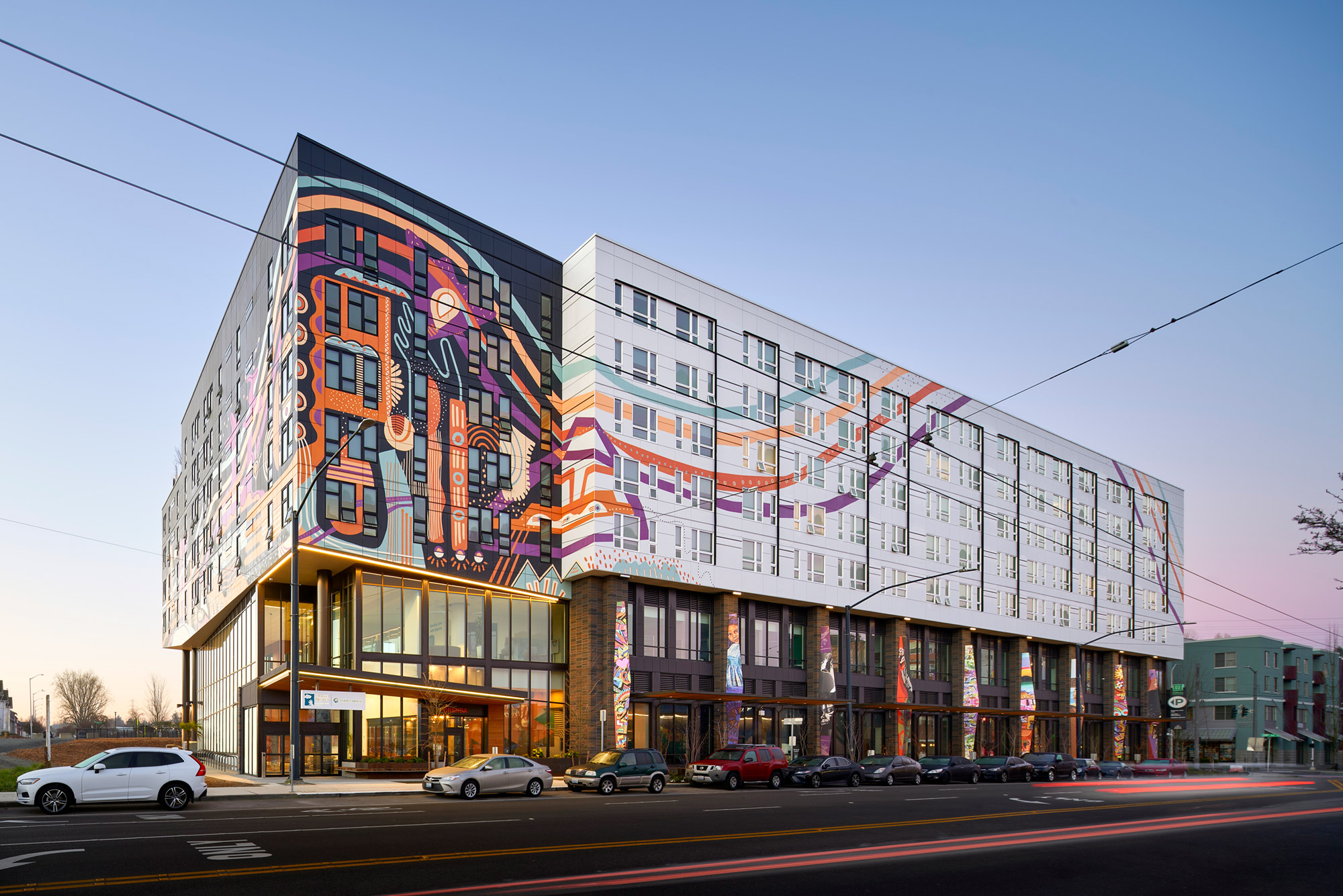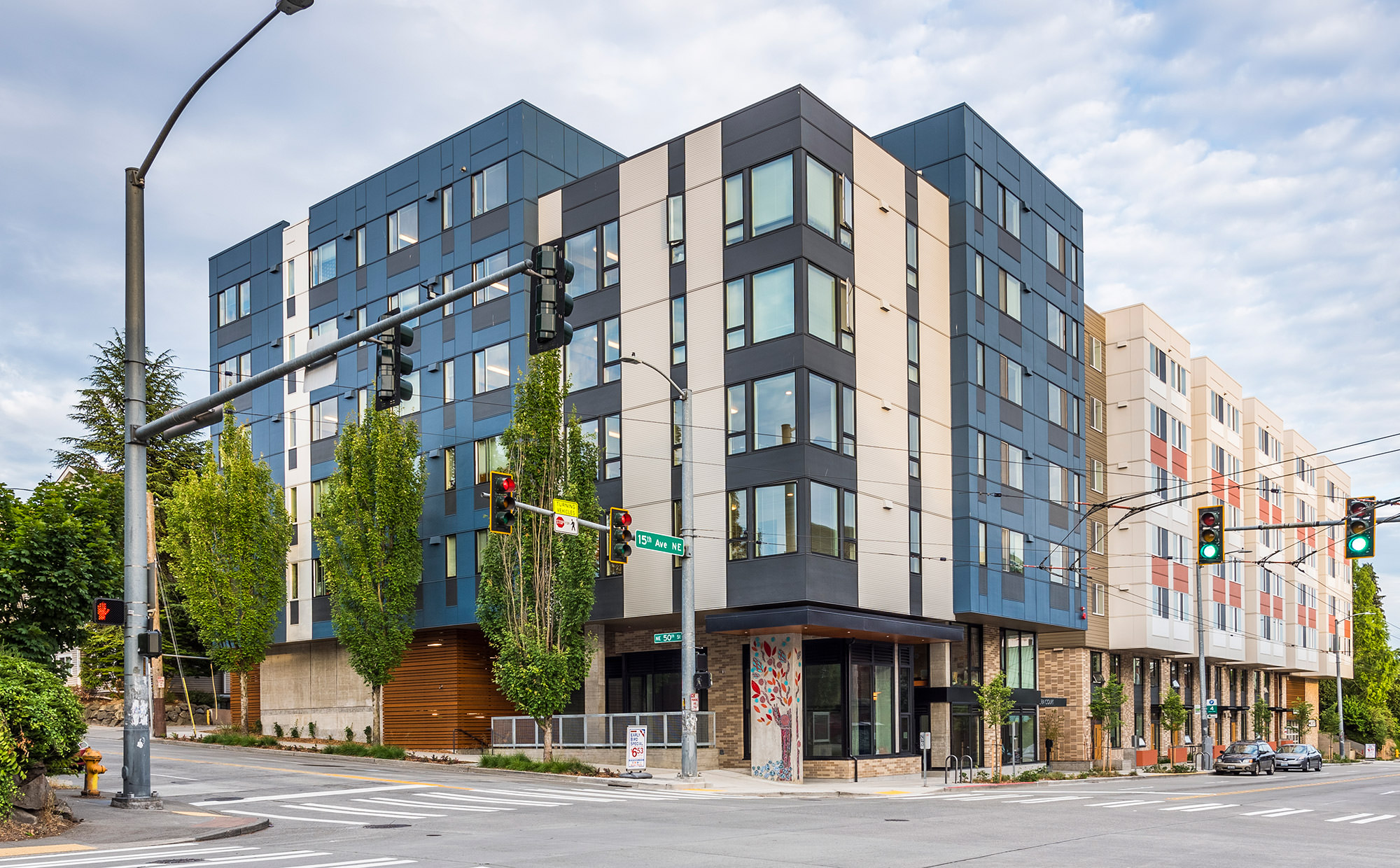Raven Terrace at Yesler Terrace
Raven Terrace at Yesler Terrace is the first low-income housing development in the master planned Yesler Terrace neighborhood near downtown Seattle. A Seattle Housing Authority project, the building is HUD funded and complies with Evergreen Sustainable Development Standards, as well as Enterprise Green Communities criteria.
Client Name
Seattle Housing Authority
Location
Seattle, WA
Services
Architecture
Interior Design
Landscape Architecture
Contacts
Scott Thompson
Principal in Charge
Jeff Reibman
Senior Principal, Project Contact
Bernadette Kelly
Interior Design Principal
Rachael Meyer
Landscape Architecture Principal
Program Overview
330′ Tower / 7 Floors
30,000 SF Site
87,967 GSF
4,971 SF Retail
73,583 SF Residential
83 Residential Units
29 Parking Stalls
Approximately 1,250 SF Green Roof System
Completion Date
Q1 2016
Certifications
Evergreen SDS/LEED-H Gold
Awards
2017 Affordable Housing Finance Awards
People’s Choice Award
Best Public Housing Redevelopment
2016 WASLA Awards
Merit Award
Residential Design Multi-Family
2016 Gold Nugget Awards
Award of Merit Honoree
Best Multifamily Housing Community – 60 du/acre or more
2016 Builder’s Choice Awards
Citation Award
Affordable Housing
Services
Weber Thompson was the architect and landscape architect for Raven Terrace, and also provided interior design services for the building. A harmonious combination of architectural, landscape and interior elements provides continuity of color and form throughout.
PHOTOGRAPHY: WEBER THOMPSON, ROBERT WADE PHOTOGRAPHY
Raven Terrace at Yesler Terrace Architecture
Raven Terrace is the first affordable multifamily building completed in Seattle’s Yesler Terrace neighborhood, a community rich in history perched on a hill just minutes from Seattle’s central business district.
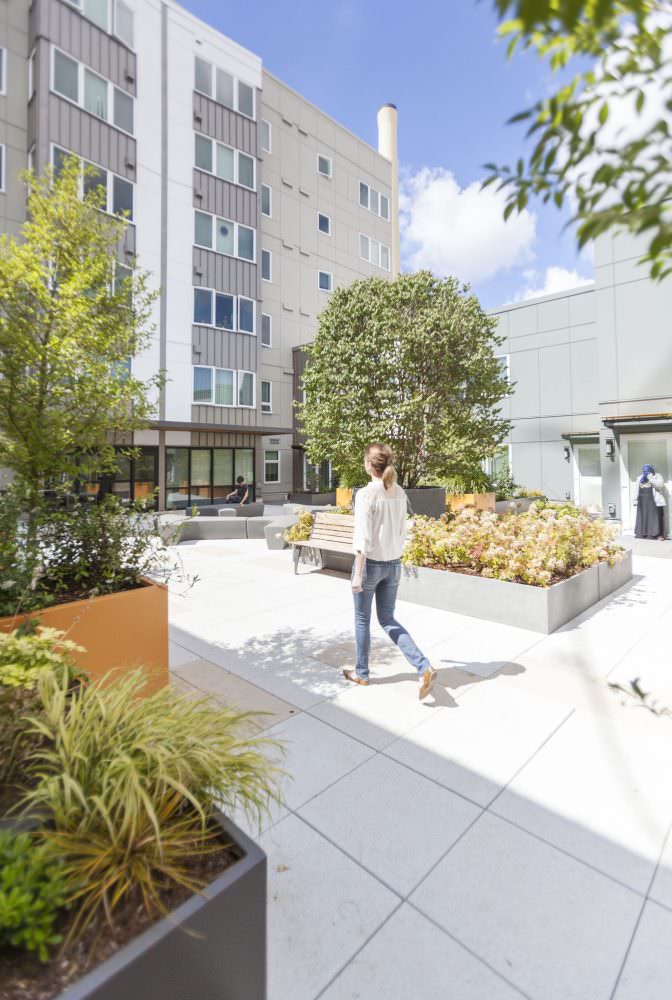
Adapting to a layered context
The new structure needed to meld within the diversely layered context. With downtown’s modern skyscrapers as a backdrop contrasting Yesler Terrace’s friendly pedestrian scale and a smattering of historic buildings, Raven Terrace needed to be both contemporary and sophisticated as well as charming and timeless. An eight-story “tower-ette” on the site’s street corner is perched above three-story townhouses which branch off at the base. This massing responds well to the urban environment and adds much needed density to the site to better serve the low-income community.
This building massing also allows light and air to permeate through the site. As the grade rises along the street, the townhouses reduce to two-stories above the sidewalk. With bays clad in ribbed metal panels and anchored by residential stoops, the townhouses create rhythm and provide pedestrian level details along the main street frontage and sidewalk.
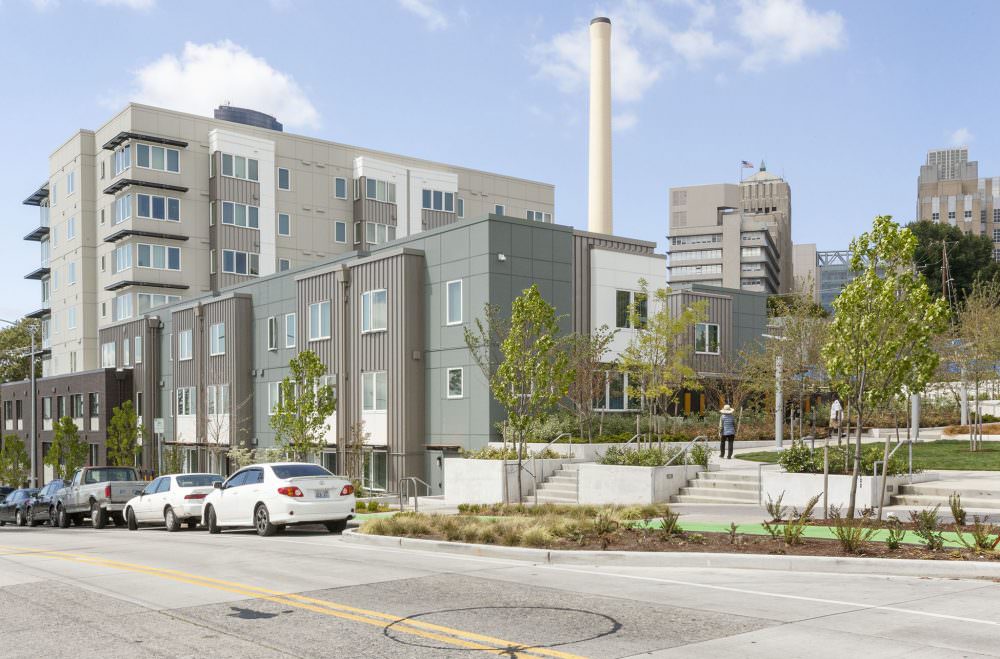
Spectacular views
The plan affords sweeping views of the city and optimizes efficiency and privacy by using a tower-like floor plate. By keeping the taller massing compact, the development also preserves views of the adjacent historic steam plant’s chimney which is an icon for the neighborhood. At the base, a three-story brick podium wraps the taller massing adding texture and charm to simple volumes within the pedestrian realm.
Raven Terrace at Yesler Terrace Interior Design
At Raven Terrace, the design team let residents drive the design. To better understand the diverse backgrounds and unique needs of our residents, Weber Thompson met multiple times with the neighborhood community group and interpreters helped us dialogue with the many cultures present. The design team used dot exercises to understand preferences, and the ways in which residents would live and use their units.
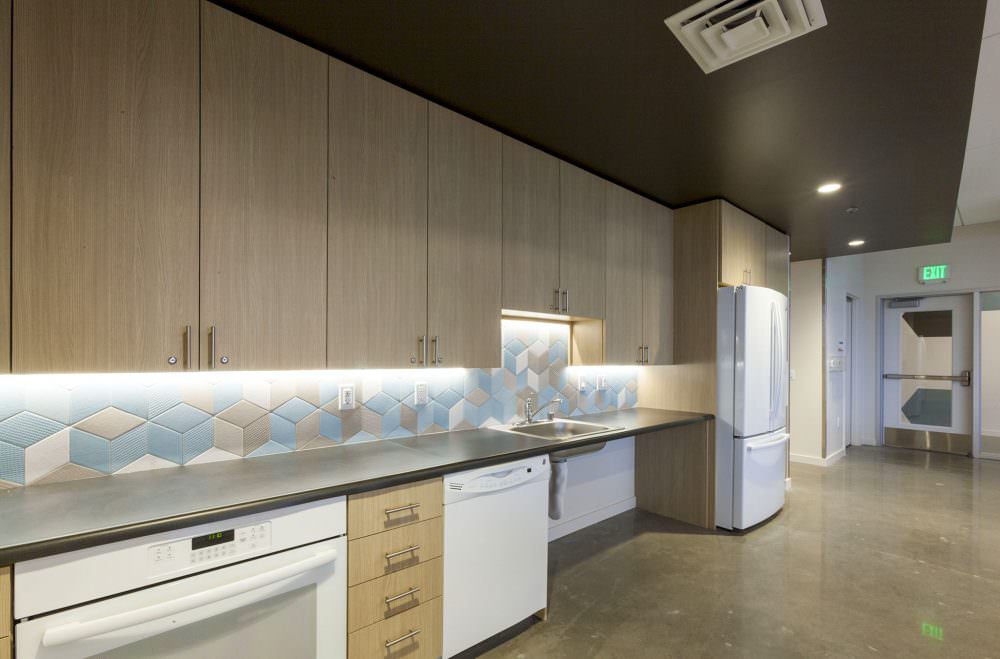
Meeting resident needs
Kitchen openness was adjusted to reflect cultures’ desire to screen cooking from living spaces. Multi-bedroom units were grouped around common areas so residents with families can be near other families. Residents also had a voice in color selection for the building expressing a preference for muted colors to blend with the community rather than stand out.
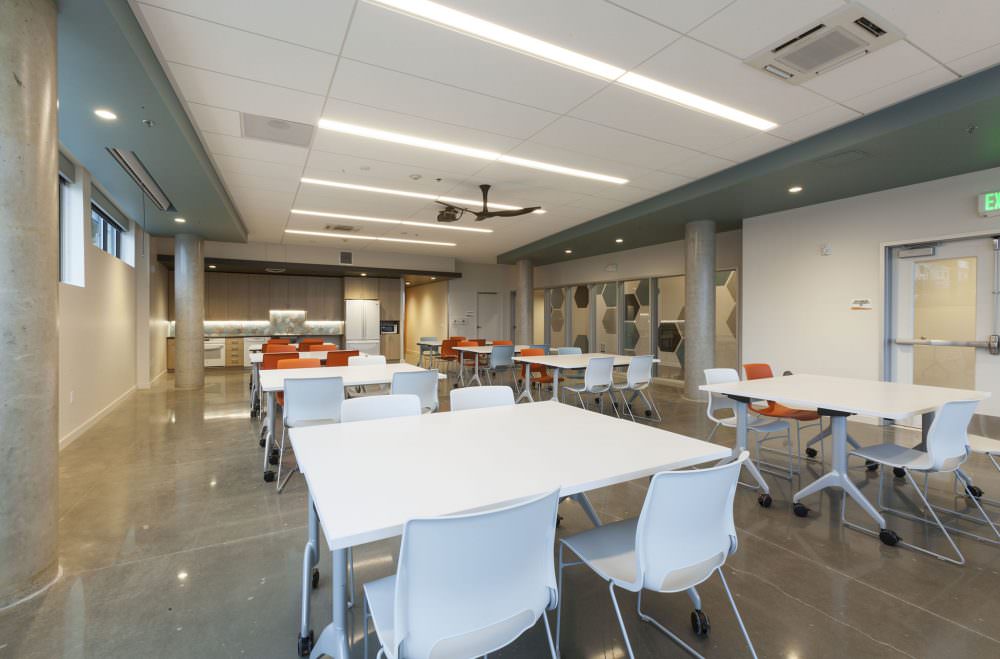
A place for the community
Meeting community needs was a key driver for the project. A community meeting room was carved out of the lower floor and designed to support flexibility of use. A kitchen along the back wall can be used for community events or caterers, and furniture supports meetings and gatherings of all kinds. An adjacent hallway is lined with glass and abuts the community room, which is used as a childcare space during important ‘adult’ meetings. Decorating the hallway with pops of color are hexagonal shapes, based on the idea of beehives – or a buzzing community – a subtle parallel to the thriving community of Yesler Terrace.
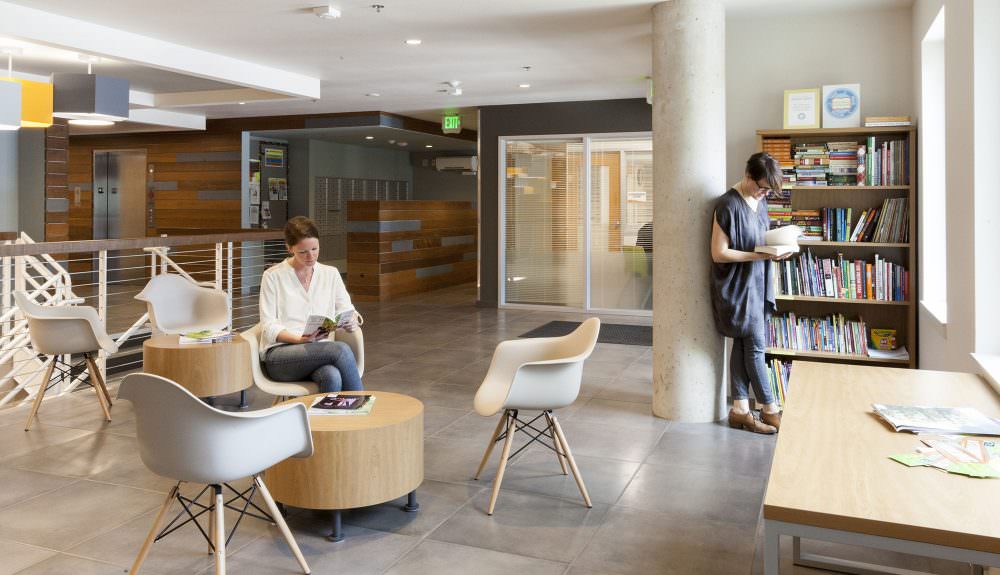
Supporting lifelong learning
Activist, author and educator Jonathan Kozol believes that low-income children and families need access to books, and that designers need to provide shared bookshelves in their designs. To this end, the project team helped create a lending library for Raven Terrace. They collected donations from staff, friends and family, and purchased books at the Friends of the Seattle Public Library book sale. The lending library includes over 250 kids’ books, young adult books, reference books and novels in English, Mandarin, Arabic and Cantonese.
Raven Terrace at Yesler Terrace Landscape Architecture
The landscape design at Raven Terrace supports a thriving internal community as well as connection with the surrounding neighborhood.
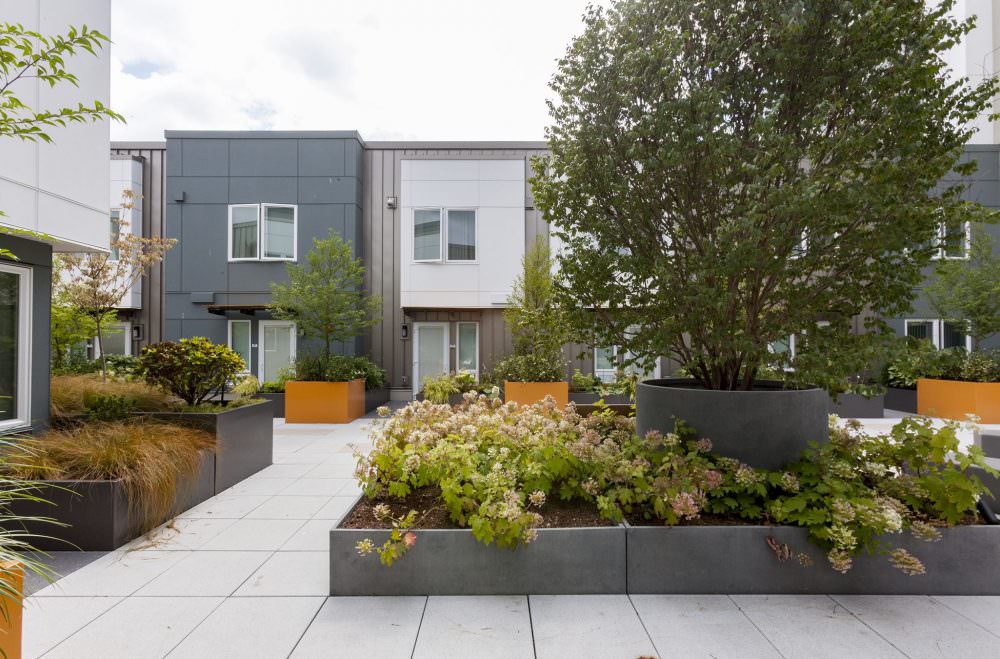
A grand entrance
The development consists of units for residents who make 30% of the area median income; most residents travel on foot. A unique entry experience was customized to residents’ lifestyles which has become a special feature of the building. Townhouses’ front doors face the interior of the courtyard and a small plaza space with flexible seating creates opportunities for social engagement in a safe and secure environment.
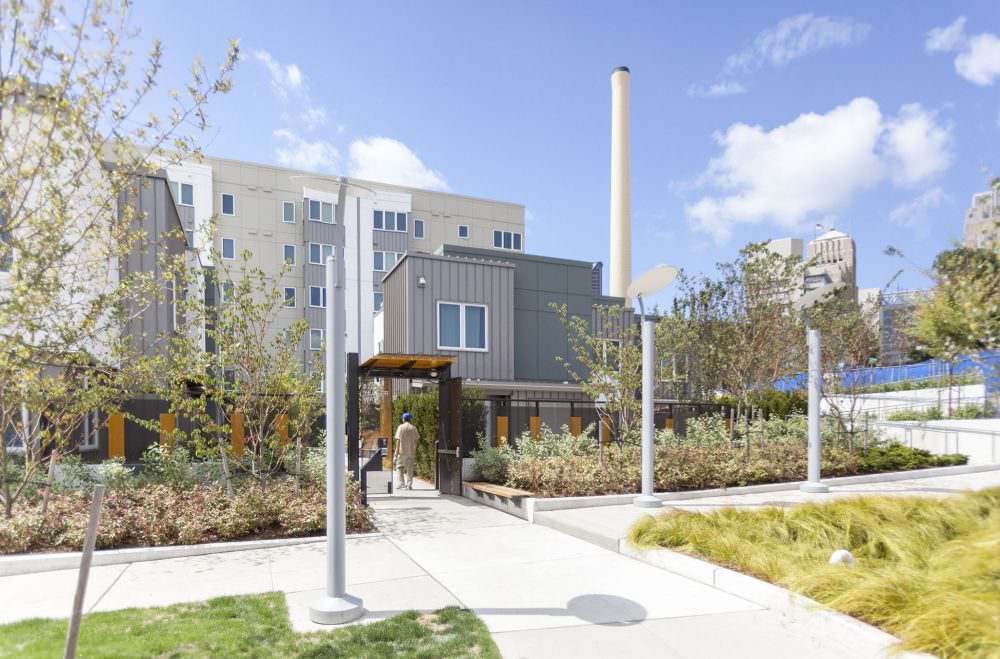
Connecting walkways
A midblock pedestrian path linking the neighborhood engages the sidewalk creating an easy route for pedestrians through the city and around Raven Terrace’s site. At thirty feet wide, the pedestrian path serves more like a mini park. Benches provide places to rest beneath trees along the path. As the pedestrian pathway climbs the site, the townhouse wings open to reveal a private courtyard for Raven Terrace residents. This is where the building’s main entry lives.
Sustainability
Raven Terrace is designed to meet both Evergreen Sustainable Development Standards and Green Communities.
The developers sought ways to reduce environmental impact, reflected in everything from the flooring specification, to the HVAC equipment and planter locations. Several of the sustainable strategies established new operational standards for the property owner. For example, the individual units have heat recovery ventilators (HRV) driven by the fact that residents were frequently found taping up more conventional means of fresh air supply via window trickle vents. HRVs allow replacement air to adjust to the interior temperature before entering habitable space, improving occupant comfort and energy efficiency. The building uses LED light fixtures throughout.
The project makes use of downspouts from the townhouse roofs to direct water from the roofs to stormwater planters below. The stormwater planters absorb roof runoff and both slow rainwater and reduce the volume going to the City’s storm drainage system. The downspouts double as compositional elements on the building façade.
Raven Terrace at Yesler Terrace in the News
Local focus: What can we do about homelessness and affordable housing? Change attitudes and funding
Arcade Magazine
October 24, 2018
ULX: Ten affordable housing projects
Urban Land Magazine
July 9, 2018
SHA receives national honor
Daily Journal of Commerce
September 21, 2017
Seattle architects win awards for multifamily housing projects
Daily Journal of Commerce
July 23, 2016
Design perspectives: New paths and parks make Yesler Terrace shine
Daily Journal of Commerce
May 4, 2016
Yesler Terrace continues overhaul
King 5
February 12, 2016

